Traditional ground beds are great but raised beds are a good option for growing plants. There are many benefits of raised bed gardening, you can avoid bending and kneeling, grow more food in small areas, less weeding, less danger of pests, and last but not least easy to maintain.
You can maintain the fertility of the soil which is not possible in-ground beds plus soil in a raised bed warms earlier in the planting season.
In this article, we are going to discuss some tips and instructions which you should consider before building a raised bed. Little planning and prevention make it possible for you to avoid any future problems.
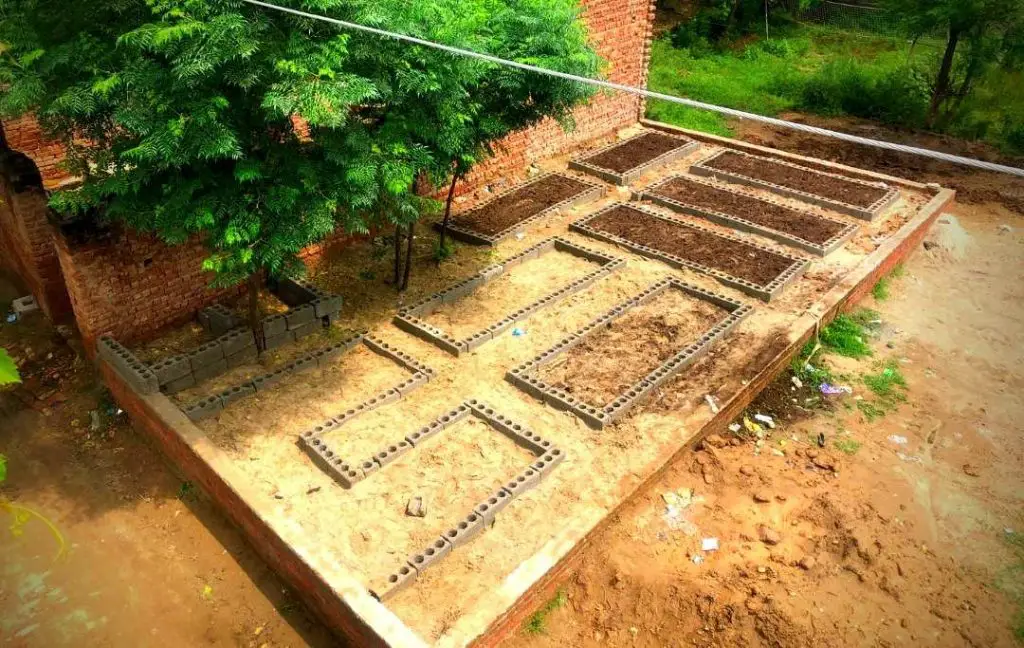
A simple raised bed will change the look of your garden, you should plan an aesthetically pleasing arrangement for your garden by building raised beds. I hope this article will help you a lot and give you all the basic information.
1- SHOULD I PUT LANDSCAPE FABRIC UNDER RAISED BED?
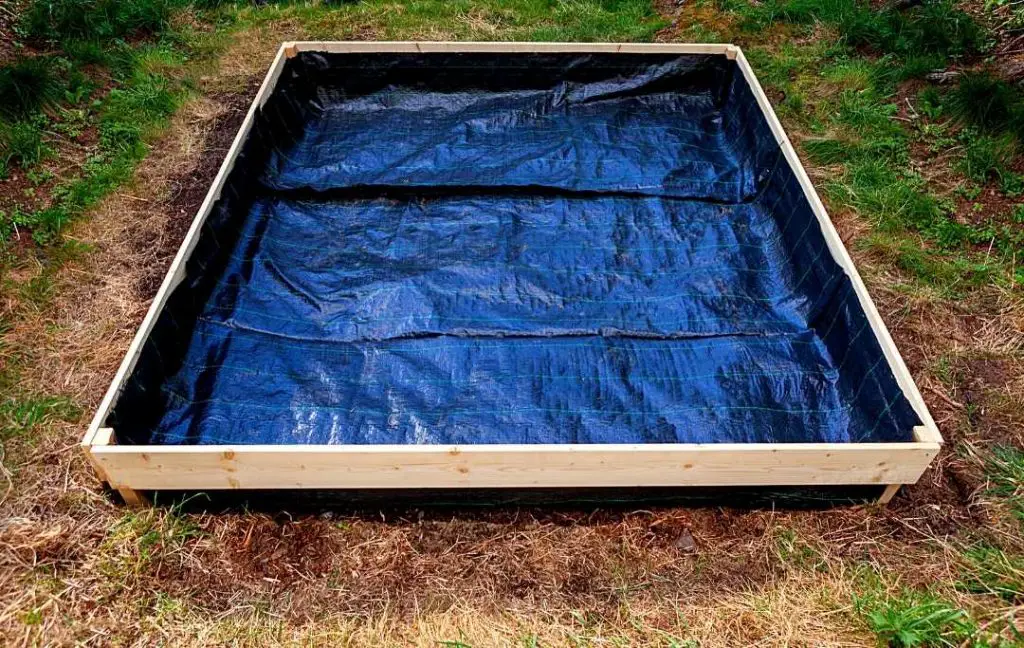
If you are thinking of putting your raised bed on the grass then it is not a good idea. There are many things such as plastic, cardboard, landscape fabric, and newspaper which you can put under a raised bed before filling it with high-quality soil.
Landscape fabric has holes in it for drainage that’s why you can use it to line the bottom of your raised bed. It is suggested due to the following reasons:
- It will prevent your bed from weeds. It is very effective at keeping unwanted plants’ growth in your raised bed. If you don’t want to deal with the weeds then you should install a barrier at the bottom.
- The burrowing pests such as voles, moles, and gophers will not enter your beds easily. A barrier makes it impossible for such burrowing creatures to access your bed. So the roots of your plants are saved from these creatures and they are not able to eat the roots.
2- SHOULD I PUT ROCKS IN THE BOTTOM OF MY RAISED GARDEN BED
By building a raised bed you can avoid problems such as poor and rocky soil. If you add rocks to the bottom of the raised bed it will improve drainage. You can buy crushed rock from home improvement centers or rock yards.
When your raised bed is built then dump the crushed rocks or gravel into the raised bed framed space. You can use a metal rake for spreading the rocks. The layer of rocks must be 2 to 3 inches. The benefits of adding rocks are as under:
- Most plants require well-drained soil so if you place rocks in the bottom then you can create additional drainage space.
- Excess moisture in the soil will become the reason for root rot which kills delicate plants. A layer of rocks at the bottom makes space for excess water to drain. It is the quality of rocks they will not compact over time.
3- BEST HEIGHT FOR RAISED GARDEN BED
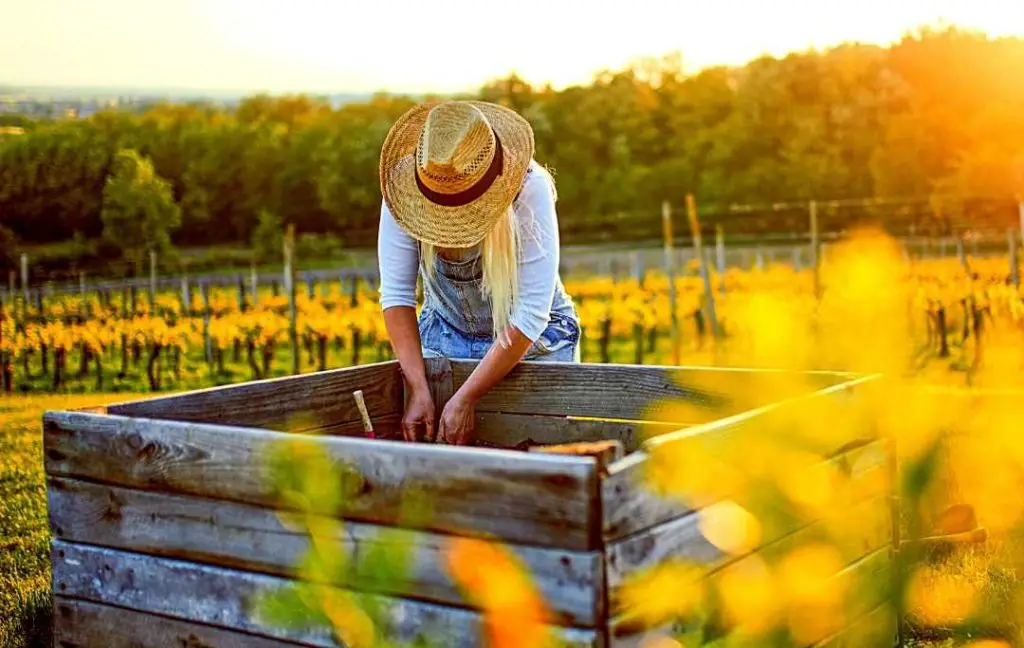
The perfect height for the raised bed is 10 to 12 inches. If you are planning for growing deep root vegetables then the height of your raised bed should be 12 to 18 inches.
As they needed more room to grow so a deep raised bed is suggested. In some cases, the height of the raised bed can be 36 inches. If you are planning to grow herbs then 6 inches will also work.
4- HOW DEEP SHOULD A RAISED GARDEN BED BE?
More depth means your plants have more room to grow. The other advantage of a deeper raised bed is that it can hold more soil and more moisture. More depth has more soil then it will pressurize the sides of raised beds so you should use thicker wood for support.
For the root growth of deep-rooted vegetables, more depth is needed, 10 to 18 inches depth is needed. If you are growing herbs then there is no need for a deep raised bed, 6 inches deep raised bed also works great. But the height of the raised bed can be easily handled.
As you increase the height then you need more soil to fill it. As your soil needs nutrients for the plants so the number of organic materials which you add will be also increased.
If the quantity of the soil is increased then you should use thick wood for building raised beds so it can hold a large amount of soil in your high raised bed.
5- HOW WIDE SHOULD A GARDEN BED BE?
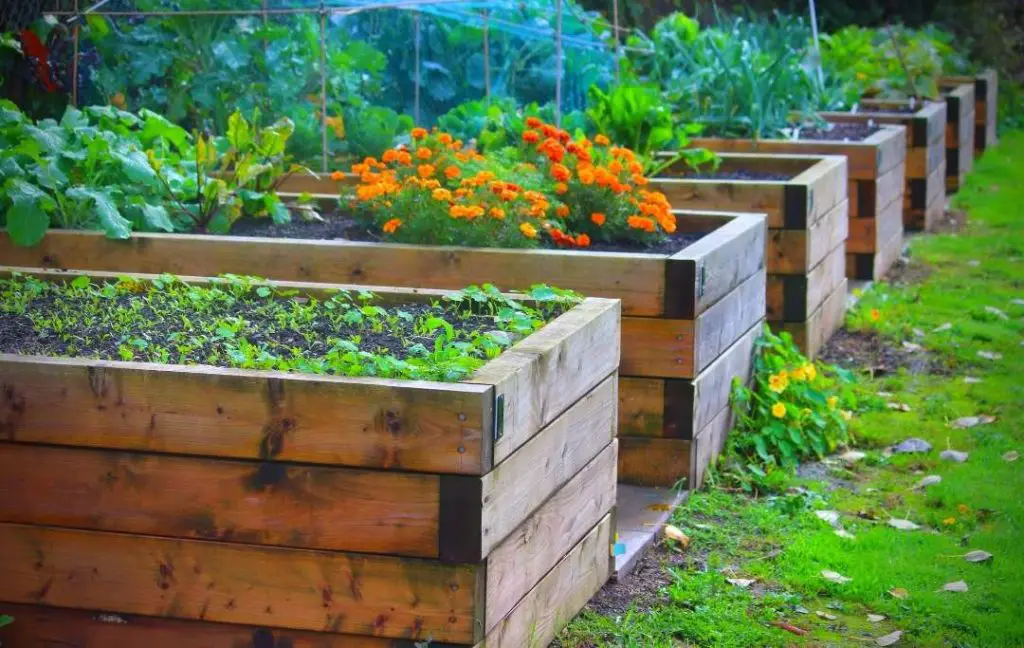
The dimension of the raised bed is very important. If you are building more than one bed then leave the space between them to walk around each bed. The width of the bed should not be more because you can’t manage the plants easily and it is not possible for you to reach the centre of the bed.
The general width of the raised be should be 4 feet but it is best if you limit it to 3 feet. If you are building a bed against a wall or a fence then the width should be 2-3 feet means 60 to 90cm. The reason is that there is only one side available to access the bed. The length of the raised bed depends on the size of your garden or yard.
6-RAISED GARDEN BED DISTANCE FROM HOUSE
There should be some distance between the house and the raised bed. It is better to leave an inch and a half-space between the wall of the house and the raised bed.
But you can increase the space according to your choice. First, you should take the measurement and after that mark this on the sleeper. It is not necessary to locate the garden too far from the house.
A 2×2 stake will help to create a distance between the house and the bed. Place the stake in the middle point means between the raised bed and walls of the house. This distance is about 6 inches so the foundation of your house is safe from moisture.
7- BEST WALKWAYS BETWEEN GARDEN BEDS
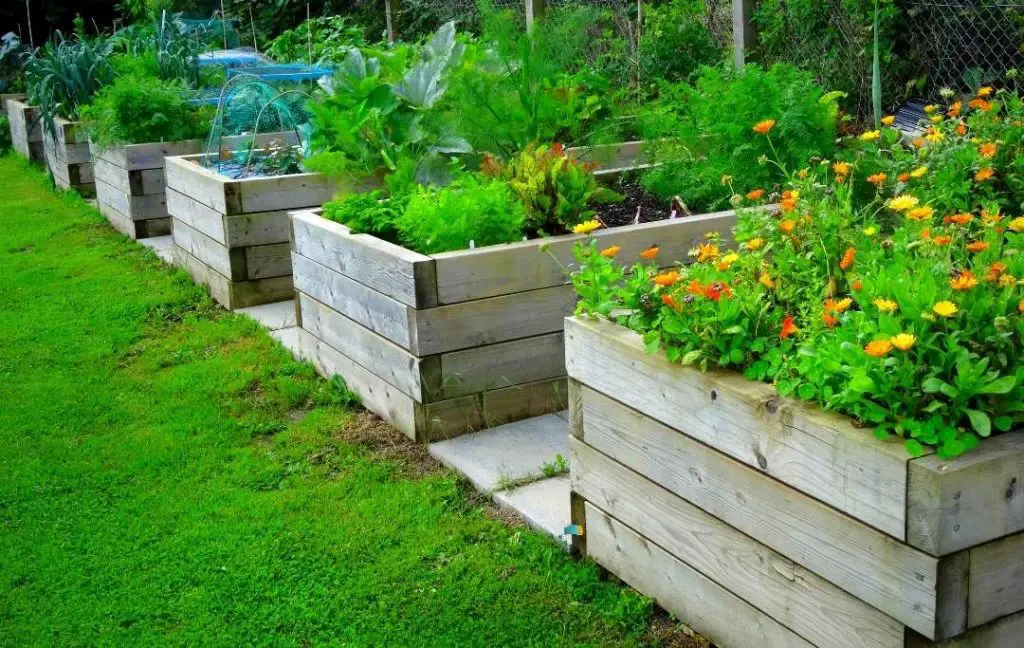
The narrow paths between the raised bed can become a headache. Weeding and harvesting become a problem for you if you don’t leave proper space between the raised beds.
The walkways between the beds should be properly built so you can maintain your plants properly. You can create a pathway by using bricks as it is inexpensive. Bricks come in different colors and sizes.
If you are living in cold areas then you should use hard bricks rather than softer ones. First, you should calculate the number of bricks you want to make the walkways. Simply, line up the bricks one by one along with the raised bed.
With basic bricks, you can create a limited pattern. The common patterns you can make are basketweave, straight rows and herringbone. You can use different colors of bricks and make a unique pattern by using your aesthetic sense.
First, level the path with the help of how and smooth the surface with a rake. If there are any low areas then fill them with sand or soil You can use a brick chisel to create a reasonable cut.
Position the brick and noted the length, after that set the brick on the slab of steel. Now a hammer will help you to fit the bricks and create your pattern.
If you want to avoid the weeds then don’t leave any space between the bricks. The gaps between the bricks can be filled with sand. Now your path is ready, you can decorate it with your creativity.
8- GRAVEL AROUND RAISED BED
This is another important tip which is filling around your bed with gravel. If you see weeds or grass then cut them back and cover them with a cardboard or weed barrier before placing gravel.
This idea will work to keep the weeds away from your bed. It may be possible that you will find a few weeds in the gravel but don’t worry they are not many.
In the case of weeds, don’t pull them. Move the gravel to the side, lay a piece of cardboard over the weed. After that remove the gravel and let the weeds choke out the cardboard.
9- BEST SIZE FOR RAISED GARDEN BEDS
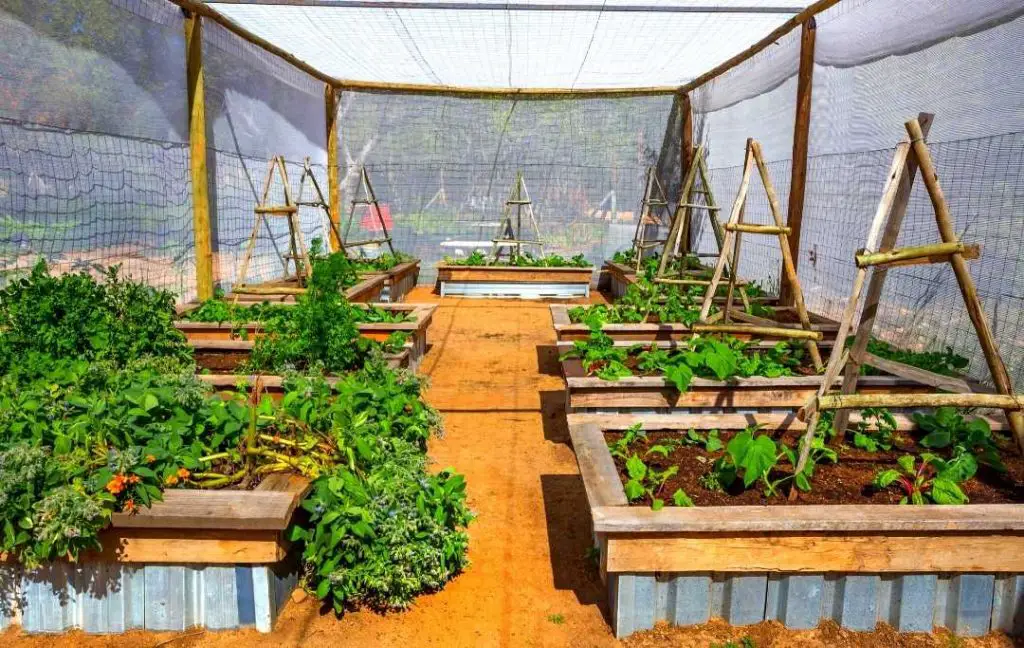
The shape of the raised bed can be rectangular, square, oval, or circular. The raised bed makes it possible to grow your plants in those areas where poor soil is available.
You can maintain the fertility of the soil easily if you are building your own raised bed besides growing the plants in the in-ground bed. If you construct the right size of a raised bed then you can follow the square-foot gardening.
If you construct the proper size of a raised bed then your excess is possible to each side of the bed. The width of the raised bed should be 3-4 feet and the length should b 6 to 8 feet.
This will allow you to easily access from the sides of the raised bed to your plants you can easily dig and weed without stepping into the bed. So your soil will be free from the risk of compacting.
This is the ideal size of a raised bed but the size of the raised bed depends upon your choice and is available in your garden. It also depends on which plants or vegetables you are growing.
If you are growing deep-rooted vegetables then they need more depth as compared to other plants. Raised gardening will maximize the space of your garden.
10- HERB GARDEN LAYOUT RAISED BED
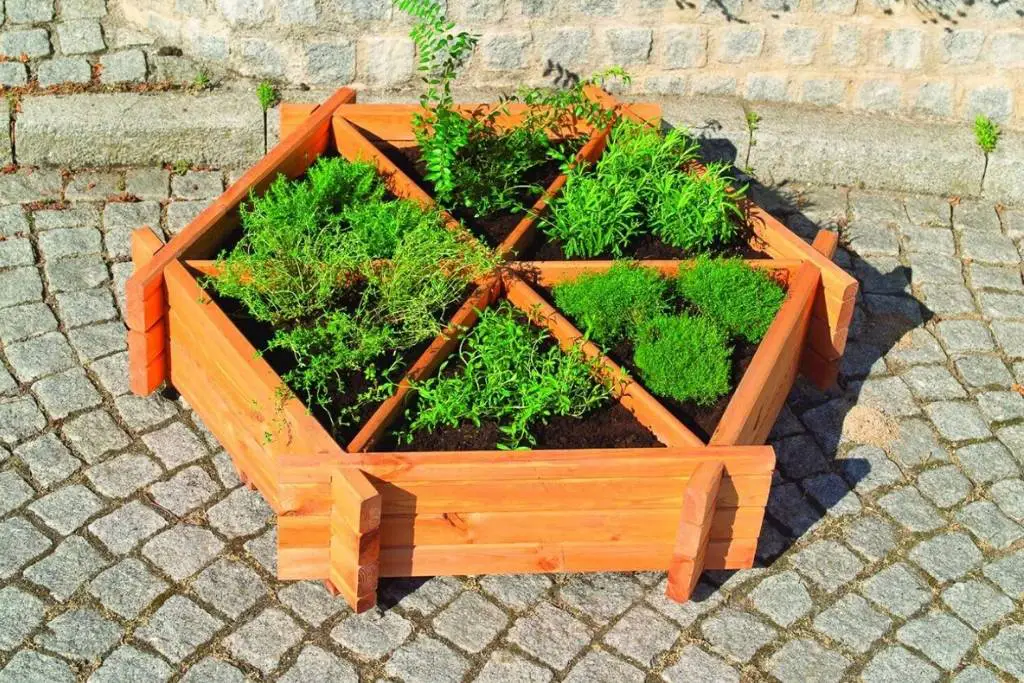
You can create a perfect herb garden with the help of a raised bed. You can position the raised bed anywhere and maintain them easily. If you are growing herbs for cooking then you should place the raised bed near your kitchen. The location of your herb-raised bed should be where your plants get full sun.
The soil of the raised bed should be rich in nutrients so you should add compost and high nitrogen feeds. In this way, delicate herbs will grow fast with great flavor.
The layout of the herb garden is very important. The taller plants like rosemary should be planted in the center of the bed. The shorter spreading herbs should be grown near the edges of the raised bed.
This will make harvesting and weeding easier. Always leave the space between the herbs so the herbs will spread. For a pleasantly aromatic and ornamental display, you should plant different varieties of herbs.
The common herbs which you can grow easily in the raised bed are parsley, chives, basil, rosemary, tarragon, oregano, thyme, and sage.
The delicate and young herb plants need protection until they are established. Raised beds make weeding easy and you can effortlessly remove the dead leaves and branches. This can be done because raised beds make it possible for you to easily access your herbs.
Cut the herbs but not more than a third of the plant and above the nearest leaf intersection. It is suggested that use fresh herbs but you can store them for later use. You can freeze them or dried them and see them when needed.
